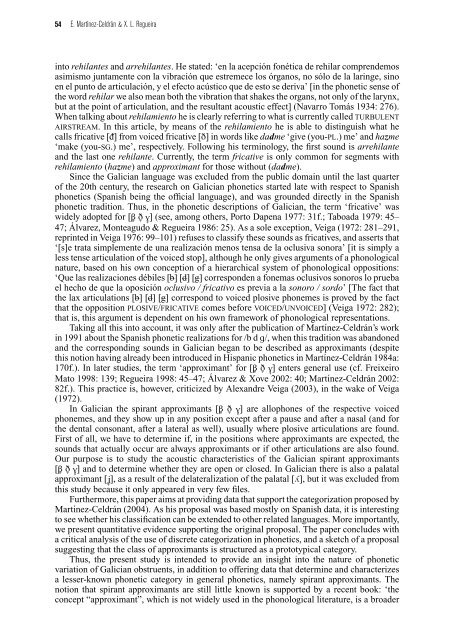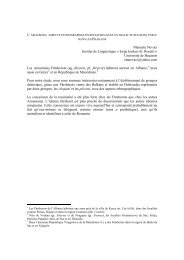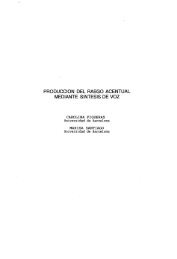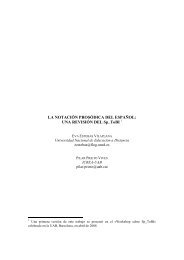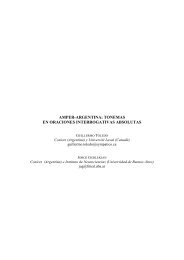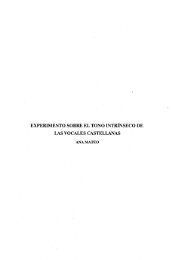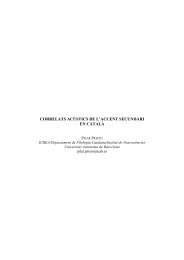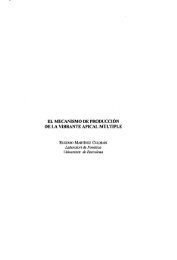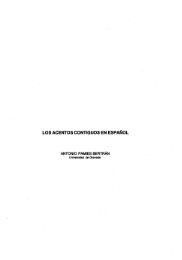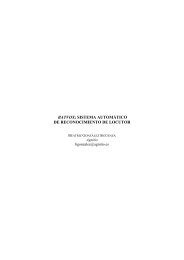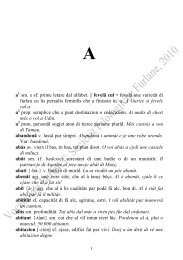Spirant approximants in Galician - ResearchGate
Spirant approximants in Galician - ResearchGate
Spirant approximants in Galician - ResearchGate
Create successful ePaper yourself
Turn your PDF publications into a flip-book with our unique Google optimized e-Paper software.
54 E. Martínez-Celdrán & X. L. Regueira<br />
<strong>in</strong>to rehilantes and arrehilantes. He stated: ‘en la acepción fonética de rehilar comprendemos<br />
asimismo juntamente con la vibración que estremece los órganos, no sólo de la lar<strong>in</strong>ge, s<strong>in</strong>o<br />
en el punto de articulación, y el efecto acústico que de esto se deriva’ [<strong>in</strong> the phonetic sense of<br />
the word rehilar we also mean both the vibration that shakes the organs, not only of the larynx,<br />
but at the po<strong>in</strong>t of articulation, and the resultant acoustic effect] (Navarro Tomás 1934: 276).<br />
When talk<strong>in</strong>g about rehilamiento he is clearly referr<strong>in</strong>g to what is currently called TURBULENT<br />
AIRSTREAM. In this article, by means of the rehilamiento he is able to dist<strong>in</strong>guish what he<br />
calls fricative [ ¯d] from voiced fricative [D] <strong>in</strong> words like dadme ‘give (you-PL.) me’ and hazme<br />
‘make (you-SG.) me’, respectively. Follow<strong>in</strong>g his term<strong>in</strong>ology, the first sound is arrehilante<br />
and the last one rehilante. Currently, the term fricative is only common for segments with<br />
rehilamiento (hazme) andapproximant for those without (dadme).<br />
S<strong>in</strong>ce the <strong>Galician</strong> language was excluded from the public doma<strong>in</strong> until the last quarter<br />
of the 20th century, the research on <strong>Galician</strong> phonetics started late with respect to Spanish<br />
phonetics (Spanish be<strong>in</strong>g the official language), and was grounded directly <strong>in</strong> the Spanish<br />
phonetic tradition. Thus, <strong>in</strong> the phonetic descriptions of <strong>Galician</strong>, the term ‘fricative’ was<br />
widely adopted for [B§ D§ V§] (see, among others, Porto Dapena 1977: 31f.; Taboada 1979: 45–<br />
47; Álvarez, Monteagudo & Regueira 1986: 25). As a sole exception, Veiga (1972: 281–291,<br />
repr<strong>in</strong>ted <strong>in</strong> Veiga 1976: 99–101) refuses to classify these sounds as fricatives, and asserts that<br />
‘[s]e trata simplemente de una realización menos tensa de la oclusiva sonora’ [it is simply a<br />
less tense articulation of the voiced stop], although he only gives arguments of a phonological<br />
nature, based on his own conception of a hierarchical system of phonological oppositions:<br />
‘Que las realizaciones débiles [–b] [–d] [–g] corresponden a fonemas oclusivos sonoros lo prueba<br />
el hecho de que la oposición oclusivo / fricativo es previa a la sonoro / sordo’ [The fact that<br />
the lax articulations [–b] [–d] [–g] correspond to voiced plosive phonemes is proved by the fact<br />
that the opposition PLOSIVE/FRICATIVE comes before VOICED/UNVOICED] (Veiga 1972: 282);<br />
that is, this argument is dependent on his own framework of phonological representations.<br />
Tak<strong>in</strong>g all this <strong>in</strong>to account, it was only after the publication of Martínez-Celdrán’s work<br />
<strong>in</strong> 1991 about the Spanish phonetic realizations for /bdg/, when this tradition was abandoned<br />
and the correspond<strong>in</strong>g sounds <strong>in</strong> <strong>Galician</strong> began to be described as <strong>approximants</strong> (despite<br />
this notion hav<strong>in</strong>g already been <strong>in</strong>troduced <strong>in</strong> Hispanic phonetics <strong>in</strong> Martínez-Celdrán 1984a:<br />
170f.). In later studies, the term ‘approximant’ for [B§ D§ V§] enters general use (cf. Freixeiro<br />
Mato 1998: 139; Regueira 1998: 45–47; Álvarez & Xove 2002: 40; Martínez-Celdrán 2002:<br />
82f.). This practice is, however, criticized by Alexandre Veiga (2003), <strong>in</strong> the wake of Veiga<br />
(1972).<br />
In <strong>Galician</strong> the spirant <strong>approximants</strong> [B§ D§ V§] are allophones of the respective voiced<br />
phonemes, and they show up <strong>in</strong> any position except after a pause and after a nasal (and for<br />
the dental consonant, after a lateral as well), usually where plosive articulations are found.<br />
First of all, we have to determ<strong>in</strong>e if, <strong>in</strong> the positions where <strong>approximants</strong> are expected, the<br />
sounds that actually occur are always <strong>approximants</strong> or if other articulations are also found.<br />
Our purpose is to study the acoustic characteristics of the <strong>Galician</strong> spirant <strong>approximants</strong><br />
[B§ D§ V§] and to determ<strong>in</strong>e whether they are open or closed. In <strong>Galician</strong> there is also a palatal<br />
approximant [J§], as a result of the delateralization of the palatal [L], but it was excluded from<br />
this study because it only appeared <strong>in</strong> very few files.<br />
Furthermore, this paper aims at provid<strong>in</strong>g data that support the categorization proposed by<br />
Martínez-Celdrán (2004). As his proposal was based mostly on Spanish data, it is <strong>in</strong>terest<strong>in</strong>g<br />
to see whether his classification can be extended to other related languages. More importantly,<br />
we present quantitative evidence support<strong>in</strong>g the orig<strong>in</strong>al proposal. The paper concludes with<br />
a critical analysis of the use of discrete categorization <strong>in</strong> phonetics, and a sketch of a proposal<br />
suggest<strong>in</strong>g that the class of <strong>approximants</strong> is structured as a prototypical category.<br />
Thus, the present study is <strong>in</strong>tended to provide an <strong>in</strong>sight <strong>in</strong>to the nature of phonetic<br />
variation of <strong>Galician</strong> obstruents, <strong>in</strong> addition to offer<strong>in</strong>g data that determ<strong>in</strong>e and characterizes<br />
a lesser-known phonetic category <strong>in</strong> general phonetics, namely spirant <strong>approximants</strong>. The<br />
notion that spirant <strong>approximants</strong> are still little known is supported by a recent book: ‘the<br />
concept “approximant”, which is not widely used <strong>in</strong> the phonological literature, is a broader


